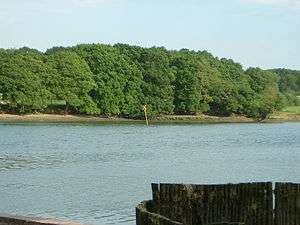Grace Dieu (ship)
 The yellow hazard marker is sited on the wreck of Grace Dieu in the River Hamble | |
| History | |
|---|---|
| Name: | Grace Dieu |
| Ordered: | 1416 |
| Builder: | William Soper |
| Launched: | 1418 |
| Commissioned: | 1420 |
| In service: | 1420-1439[1] |
| Fate: | Struck by lightning and burnt in 1439 |
| General characteristics | |
| Tons burthen: | 2,750 tons[1] |
| Length: | 218 ft (66 m)[1] |
| Beam: | 50 ft (15 m)[1] |
| Complement: | 250[1] |
| Armament: |
|
Grace Dieu was launched in 1418 as the flagship of Henry V of England and was one of the largest ships of her time. She sailed on only one voyage, and spent most of her life laid up in the River Hamble, where in 1439 she was struck by a bolt of lightning and burnt.
Design and construction
She was built to a three-layered[2] clinker-built design by William Soper, a burgess of Southampton and Clerk of the King's Ships. A dock was specially built for her construction near Town Quay in Southampton.[3]
The remains of Grace Dieu suggest that it was built in a hurry. It was certainly not made to look good: some of the planks and ribs are roughly finished. It was a vast ship built with 2735 oak, 1145 beech, and fourteen ash trees, and mounted twelve cannon. The prow rose 50 feet above the waterline, providing a large and high platform for archers to rain death on smaller ships. It was 218 feet long and 50 feet wide, making it comparable in size to HMS Victory and twice the size of Mary Rose. Grace Dieu retained the clinker technique. The ship was triple clinker – three planks were nailed together with long iron rivets to provide a thick, reinforced hull waterproofed with tar and moss sandwiched between the planks. The shipwrights and carpenters who worked on her between 1416 and 1418 were experimenting in ship design, taking a Genoese ship and applying northern principles to the construction. It must have been a work of trial and error which explains the crudeness of its timbers.[4]
Ordered in 1416 to fight Genoan carracks,[3] Grace Dieu was completed in 1418 and was one of the largest wooden ships of its time, measuring 66.4 metres (218 ft) in length. Estimates of her weight range between 1,400 tons[3] and 2,750 tons.[1] Two other ships, Valentine and Falcon were built to escort her.[3]
The problem with Grace Dieu was that by the time she was operational in 1420 the aims that had given birth to her were no longer relevant. England had control of the Channel and Castile was no longer in France’s service. The Treaty of Troyes of that year provided that Henry’s heirs should succeed Charles IV as king of France. Grace Dieu served as a useful reminder to foreign visitors that England possessed the technology and political will to claim sovereignty over the seas.[4]
1420 voyage
Grace Dieu and her escorts appear to have only set sail once, in 1420, under the command of the Earl of Devon.[3] The expedition suffered a mutiny soon after leaving Southampton and diverted to St. Helens on the Isle of Wight.[3]
Service after Henry V death and loss
When Henry V died in 1422 his ships were treated as his private property rather than as part of the kingdom's navy. Many were sold off to pay his debts.[4]
In 1430 William Soper, by now in charge of the administration of the entire navy, dined with commander of the Florentine merchant fleet on board Grace Dieu.[4]
Subsequently, Grace Dieu was laid-up in the River Hamble. Already dismasted and stripped of equipment, she was burnt to the waterline after being set ablaze by a bolt of lightning in 1439.[3]
Rediscovery
The remains of Grace Dieu are still in the River Hamble at Bursledon, near Southampton, Hampshire. Until 1933 the wreck was believed to be that of a Danish galley or a nineteenth-century merchant ship, but in that year a proper survey established both the true identity of the wreck, and the great size of the ship.[1] The site was designated under the Protection of Wrecks Act on 5 February 1974 and was excavated by Channel 4's archaeology programme Time Team in 2004 for the 2005 series. 50 metres from the remains lie those of another vessel, believed to be Grace Dieu's contemporary Holigost.[5]
See also
- List of world's largest wooden ships
- Great Harry - Henry VIII's flagship 1514; The Henry Grace à Dieu ("Henry Grace of God").
References
- 1 2 3 4 5 6 7 8 "Ships: Grace Dieu 1420". Royal Navy. Retrieved 2011-03-22.
- ↑ Time Team
- 1 2 3 4 5 6 7 Southampton an Illustrated History. Adrian Rance. 1986. ISBN 0-903852-95-0
- 1 2 3 4 Ben Wilson, Empire of the Deep; The Rise and Fall of the British Navy, Weidenfeld & Nicolson. 2013. ISBN 0297864084
- ↑ Keys, David (12 October 2015). "Henry V warship buried in Hampshire". Independent (London). Retrieved 12 October 2015.
External links
Bibliography
- R C Anderson, The Burlesdon Ship, Mariner's Mirror, Vol 20, No.2, 1934.
- M W Prynne, Henry V's Grace Dieu, Mariner's Mirror, Vol 54, No.2, 1968.
- N A M Rodger, The Safeguard of the Sea, A Naval History of Britain 660-1649 (London 1997).
- S Rose, Henry V's Grace Dieu and Mutiny at Sea: Some new evidence, Mariner's Mirror, Vol 63, No.1, 1977.
- B Wilson, Empire of the Deep; The Rise and Fall of the British Navy, Weidenfeld & Nicolson, 2013
| ||||||||||||||||||||||
Coordinates: 50°53′30″N 1°17′19″W / 50.891665°N 1.28848°W